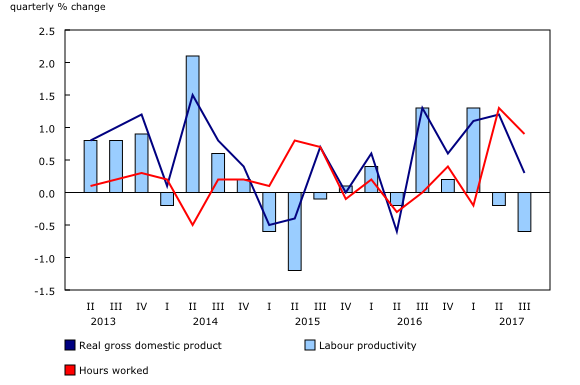Labour productivity, hourly compensation and unit labour cost, third quarter 2017
Archived Content
Information identified as archived is provided for reference, research or recordkeeping purposes. It is not subject to the Government of Canada Web Standards and has not been altered or updated since it was archived. Please "contact us" to request a format other than those available.
Released: 2017-12-06
Third quarter 2017
-0.6% 
(quarterly change)
Labour productivity falls for a second consecutive quarter
Labour productivity of Canadian businesses fell 0.6% in the third quarter, after edging down 0.2% in the second quarter and posting a 1.3% increase in the first quarter. This was the largest decrease since the second quarter of 2015 (-1.2%).
In the third quarter, business output and hours worked both increased at a slower pace than in the previous quarter, however, the increase in hours worked again surpassed the increase in output.
Real gross domestic product (GDP) of businesses edged up 0.3% in the third quarter. This was much lower than the 1.2% growth observed in the previous quarter and a deceleration was seen in both goods-producing and service-producing businesses. Mining, quarrying and oil and gas extraction, manufacturing, retail trade, and finance and insurance were the main industries that moderated the growth in output.
Hours worked in the business sector rose 0.9%, following a 1.3% increase in the second quarter. Hours worked increased at a comparable pace in both goods-producing (+0.7%) and service-producing (+0.9%) businesses. They were up in all major industry sectors, except in agriculture and forestry (-2.7%), information and cultural industries (-0.3%) and professional, scientific and technical services (-0.3%). Other commercial services (-0.1%) were virtually unchanged. The forest fires in British Columbia in July and August resulted in a decrease of only 0.08 percentage points in the quarterly change in hours worked in the business sector.
Productivity in goods-producing businesses edged down 0.3% in the third quarter, the first decrease in five quarters. Declines in the mining, quarrying and oil and gas extraction (-2.3%) and manufacturing (-1.1%) industries more than offset increases in agriculture and forestry (+1.8%), construction (+0.8%) and utilities (+0.7%).
Productivity in service-producing businesses declined for a second consecutive quarter, falling 0.4%. Productivity was down in most industry sectors, with the largest declines in real estate (-3.4%) and arts and entertainment (-3.1%). These declines were partially offset by increases in wholesale trade (+1.2%), professional services (+1.2%), other commercial services (+1.0%) and accommodation and food services (+0.4%).
In the United States, the labour productivity of businesses grew 0.9% in the third quarter, after edging up 0.3% in the second quarter. This was the highest rate of US productivity growth since the third quarter of 2014 (+0.9%). In the third quarter of 2017, growth of real GDP of American businesses continued at the same pace as in the previous quarter (+0.9%), whereas hours worked were unchanged after posting a 0.6% increase in the previous quarter. This slowdown in hours coincided with temporary disruptions caused by Hurricanes Harvey and Irma, which prevented some American workers from getting to work.
Unit labour costs increase after two quarters of decline
Unit labour costs in Canadian businesses rose 1.2% in the third quarter, after declining in the previous two quarters. This was the strongest increase since the first quarter of 2015, when a 1.6% gain was posted.
In the third quarter, the increase in unit labour costs reflected a 0.6% gain in average compensation per hour worked and a 0.6% decline in productivity. In the previous quarter, hourly compensation in the business sector was down 0.9%.
After falling in the previous quarter, hourly compensation rebounded in both goods-producing (+1.1%) and service-producing (+0.4%) businesses in the third quarter. While decreases were observed in arts and entertainment (-1.8%), information and cultural industries (-1.0%), retail trade (-0.4%), accommodation and food services (-0.4%) and administration services (-0.3%), all other industry sectors saw increases. Utilities (+2.5%) and finance and insurance (+2.3%) posted strong gains, while transportation and warehousing services was unchanged.
Following a quarter of depreciation, the average value of the Canadian dollar relative to the US dollar increased 7.3% in the third quarter. Given this strong appreciation, unit labour costs in US dollars for Canadian businesses rose 8.6%, following a 2.3% decrease in the previous quarter.
In comparison, unit labour costs of American businesses edged up 0.1% in the third quarter, equivalent to the previous quarter. In the third quarter, productivity of American businesses and hourly compensation increased at a similar pace.
Sustainable Development Goals
On January 1, 2016, the world officially began implementation of the 2030 Agenda for Sustainable Development—the United Nations' transformative plan of action that addresses urgent global challenges over the next 15 years. The plan is based on 17 specific sustainable development goals.
The release "Labour productivity, hourly compensation and unit labour cost" is an example of how Statistics Canada supports the reporting on the Global Goals for Sustainable Development. This release will be used in helping to measure the following goal:

Note to readers
Revisions
With this release on labour productivity and related measures, data were revised back to the first quarter of 2013 at the aggregate and industry levels. These revisions are consistent with those incorporated in the quarterly gross domestic product (GDP) by income and expenditure and monthly GDP by industry, published on December 1, 2017.
This release also incorporates revised annual benchmarks on the provincial and territorial economic accounts and GDP by industry published on November 8, 2017.
Productivity measure
The term productivity in this release refers to labour productivity. For the purposes of this analysis, labour productivity and related variables cover the business sector only.
Labour productivity is a measure of real GDP per hour worked.
Unit labour cost is defined as the cost of workers' wages and benefits per unit of real GDP.
All the growth rates reported in this release are rounded to one decimal place. They are calculated with index numbers rounded to three decimal places, which are now available on CANSIM.
All necessary basic variables for productivity analyses (such as hours worked, employment, output and compensation) are seasonally adjusted. For information on seasonal adjustment, see Seasonally adjusted data – Frequently asked questions.
Next release
Labour productivity, hourly compensation and unit labour cost data for the fourth quarter will be released on March 7, 2018.
Products
The System of Macroeconomic Accounts module, accessible from the Browse by key resource module of our website, features an up-to-date portrait of national and provincial economies and their structure.
The Methodological Guide: Canadian System of Macroeconomic Accounts (13-607-X) is available.
The User Guide: Canadian System of Macroeconomic Accounts (13-606-G) is also available. This publication will be updated to maintain its relevance.
Contact information
For more information, or to enquire about the concepts, methods or data quality of this release, contact us (toll-free 1-800-263-1136; 514-283-8300; STATCAN.infostats-infostats.STATCAN@canada.ca) or Media Relations (613-951-4636; STATCAN.mediahotline-ligneinfomedias.STATCAN@canada.ca).
- Date modified:


